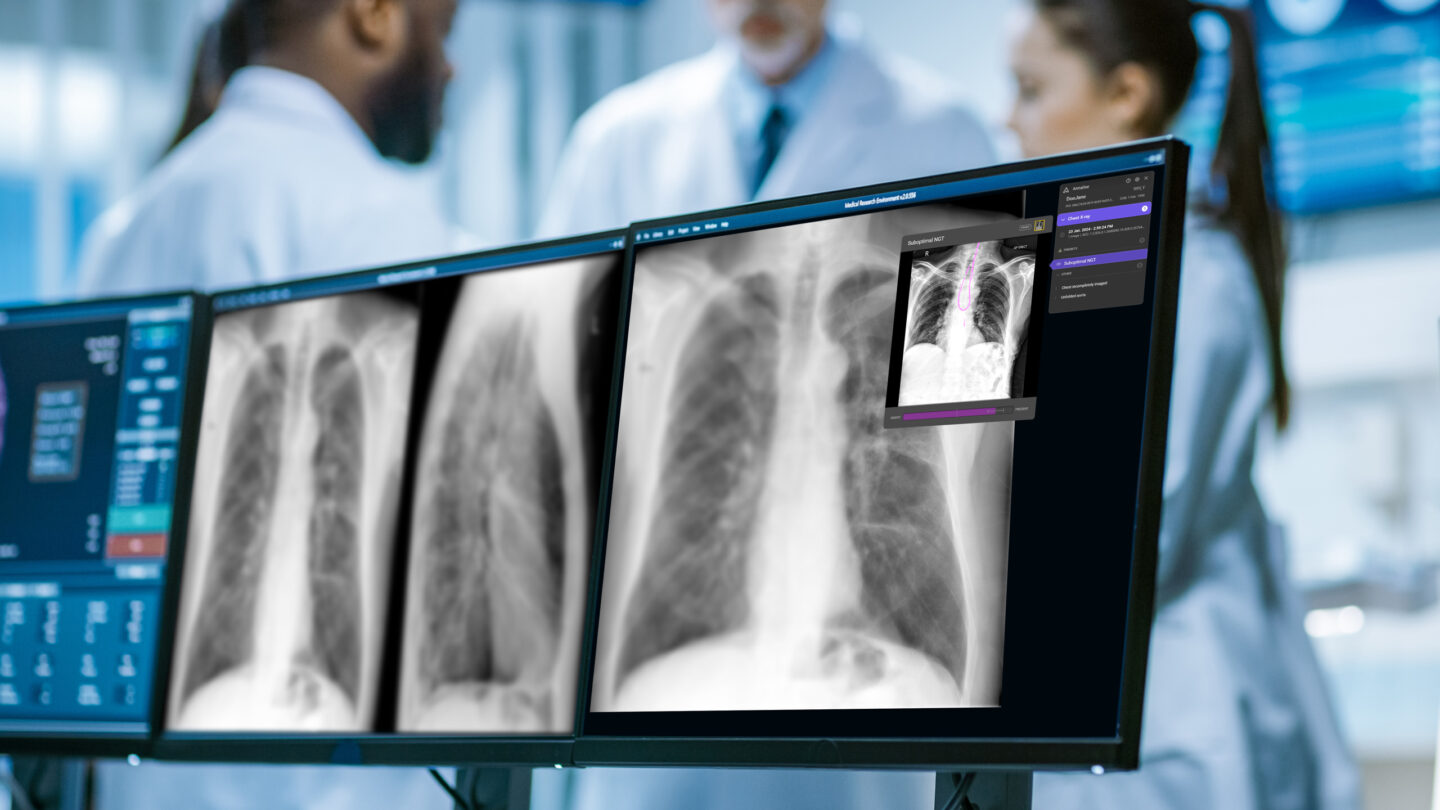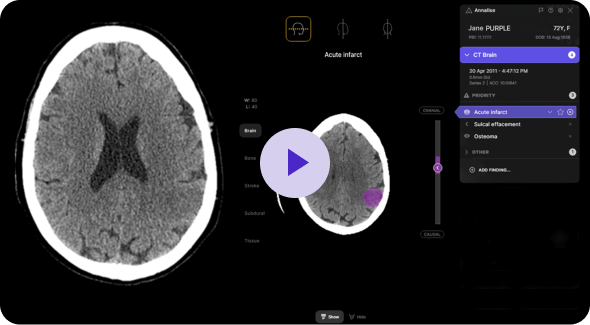Artificial intelligence is reshaping the way radiologists detect and diagnose diseases, particularly in the early detection of lung cancer.
In a recent episode of the Mancunian Matters podcast, Roisin Kennan spoke with Tom Pickersgill from our UK team to discuss the impact of Annalise.ai’s clinical support software in radiology. The conversation highlighted how our technology is assisting radiologists and, in particular, the results seen at NHS Grampian in Scotland since its deployment in 2022. Now adopted by more than 45 NHS Trusts across the UK, Annalise.ai is playing a critical role in supporting radiologists to deliver faster, more accurate diagnoses and improving outcomes for patients nationwide.
AI in Greater Manchester: A Growing Initiative
Standing outside Manchester Royal Infirmary, Roisin set the scene, explaining that in November 2024, hospitals across Greater Manchester began working with Annalise.ai: “Radiologists in the region are using two AI solutions from Annalise: one that identifies abnormalities in brain CT scans and the other which analyses chest X-rays.” She noted that the Annalise.ai chest X-ray decision-support tool has been particularly significant due to its ability to detect lung cancer at an early stage as Greater Manchester faces a higher-than-average incidence of lung cancer:
According to the NHS, the rate of lung cancer in Greater Manchester is 24% above the national average… the idea that an application like this can improve patients’ prognosis is incredibly exciting.
Annalise.ai at NHS Grampian
While the AI technology is still relatively new in Greater Manchester, it has been deployed at NHS Grampian since 2022, providing valuable data on its effectiveness. Lung cancer is the most common cancer in Scotland1, accounting for 15.5% of all cancer diagnoses2, and is responsible for almost a quarter of all cancer deaths in the country1. Early detection is critical — when identified at stage 1, the survival rate is around 65%, but this plummets to just 5% at stage 43. These figures underscore the vital importance of timely and accurate diagnosis. Tom Pickersgill, a former NHS radiographer and now UK Sales Manager at Annalise, shared some striking findings about the technology’s impact in the region.
At NHS Grampian, we’ve found that Annalise.ai detects lung cancer on average ten months earlier.4
Tom went on to explain how an earlier diagnosis can mean the difference between living many more years or facing a much poorer prognosis.

He also highlighted how AI-powered workflows have improved the speed of diagnosis and treatment. In the UK, the NHS sets a key cancer performance target, known as the 62-day wait standard, which aims to ensure that all patients referred by a GP with suspected cancer begin treatment within 62 days. Tom explained, “Before Annalise.ai was rolled out, only 52% of patients at NHS Grampian met the NHS’s 62-day wait target from GP referral to treatment. Now, 100% of patients are meeting that target5.”

AI Optimisation
One question Roisin poses is whether AI in diagnostic support can generate too many false positives – flagging abnormalities that aren’t actually there. Tom explained that our solution is designed with flexibility in mind – giving clinicians the ability to adjust sensitivity and specificity themselves, based on the needs and priorities of their service.
“The algorithm looks at 124 different findings of a chest X-ray, but we have regulatory clearance to be able to change the sensitivity and specificity,” Tom said. “If the sensitivity is too high and picking up too many false positives, we reduce that sensitivity down and increase specificity. Over the last three and a half years, we’ve continuously optimised the algorithm for performance in a UK population.”
How the AI Works
Developing AI for radiology is a rigorous process. Tom explains that Annalise Enterprise CXR was built using an extensive training process guided by expert input. Over 150 radiologists were involved in manually annotating thousands of chest X-ray images, helping the algorithm learn to identify a wide range of clinical findings.
Tom describes how the medical imaging software’s interpretation mimics a human radiologist’s approach. “The AI knows what these pathologies look like… It’s actually looking at the chest X-ray as a whole and interpreting it like a human would because it was trained by humans.”
Overcoming Barriers to AI Implementation
Deploying AI in hospitals involves more than developing the software. Tom explains that regulatory approvals, cybersecurity requirements, and NHS-specific administrative hurdles can slow the rollout process.
“The challenge becomes when NHS trusts want to roll this out… Despite being a national organisation, we still have to do these at a local level each time. So we can have patients who need this care, a department that wants to use it, even some budget set aside to pay for this, but we still might delay things from 6 to 12 months just getting through the IT processes.”
Tom suggests that streamlining approvals at a national level could accelerate AI adoption and improve patient care across the NHS.
The Future of AI in Radiology
AI is not replacing radiologists – it’s supporting them in detecting and diagnosing diseases with greater speed and accuracy. At NHS Grampian, Annalise Enterprise CXR has contributed to earlier cancer detection, enabling faster time to treatment – an outcome that can be life-changing for patients. With growing adoption across the NHS, AI tools like this are becoming a powerful asset in clinical practice.
Find out more about Annalise Enterprise CXR or book a demo with our team.
Many thanks to Mancunian Matters and Roisin Kennan, the creators of the podcast episode. Click here to listen to the episode in full.
1 Scottish Government Cancer strategy 2023 to 2033. Published 15 June 2023
https://www.gov.scot/publications/cancer-strategy-scotland-2023-2033/pages/3/
2 Public Health Scotland.
https://publichealthscotland.scot/news/2023/march/increase-in-cancer-diagnoses-in-scotland/
3 Cancer Research UK.
https://www.cancerresearchuk.org/about-cancer/lung-cancer/survival
4 Grace Project. NHS Grampian Innovation Hub. Presented by Cameron et al., ECR 2024.
5 Scottish Government. ‘Realistic Medicine – Taking Care: Chief Medical Officer for Scotland Annual Report 2023-2024’. 21 August 2024.
Annalise Enterprise CXR is intended to assist clinicians with the interpretation of radiological imaging studies. For detailed device information, including indications for use, contraindications, and warnings, please consult the user guide prior to use. Not all features are available in all regions.

